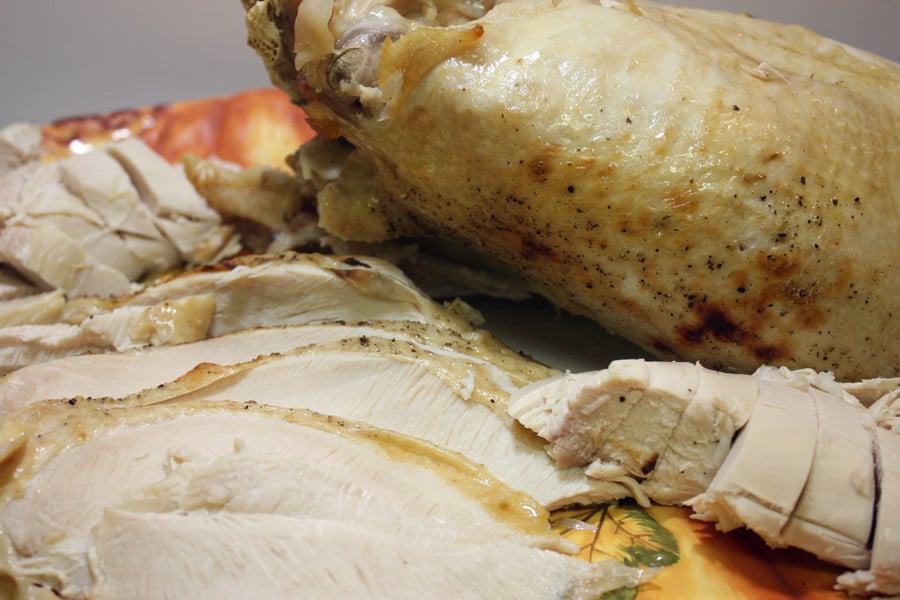Brining a turkey breast before roasting is a great way to help ensure it turns out juicy flavorful and delicious. But what exactly is brining and is it really necessary? Here’s a complete guide on brining turkey breast and why you should consider adding this simple step when cooking your holiday bird.
What is Brining?
Brining is the process of soaking meat or poultry in a saltwater solution before cooking The brine is typically made by dissolving salt and sugar in water, along with aromatic ingredients like spices, herbs, citrus and garlic
The main purpose of brining is to infuse moisture deep into the meat. The salt in the solution helps retain moisture, while also seasoning it from the inside out This results in a juicier interior and more well-seasoned flavor.
Why Brine a Turkey Breast?
There are a few key reasons why brining can vastly improve the end result when roasting a turkey breast:
-
Enhances moisture – Turkey breast meat is lean and prone to drying out during roasting. Brining helps it retain moisture and prevents the meat from becoming overly dry.
-
Boosts flavor – The salt, sugar and aromatic ingredients in the brine impart flavor and seasoning directly into the meat. This provides much more flavor than just seasoning the exterior.
-
Makes it more tender – The salt has atenderizing effect which helps break down some of the proteins in the meat. This leads to a more tender and juicy texture.
-
Allows seasoning to penetrate – Spices and herbs flavor the meat more deeply rather than just the outer surface.
-
Gives insurance against overcooking – The added moisture provides a buffer if the meat ends up cooking slightly longer than intended.
How to Make a Turkey Breast Brine
Brining a turkey breast is simple to do at home with just a few basic ingredients:
Ingredients:
- 1 gallon water
- 1 cup kosher salt
- 1/2 cup sugar
- Herbs (rosemary, thyme, sage, etc)
- Spices (peppercorns, cinnamon, allspice, etc)
- Citrus (lemon, orange, lime)
- Garlic
- Onion
- Bay leaves
Instructions:
-
Combine the water, salt and sugar in a large pot and bring to a boil. Stir occasionally to dissolve.
-
Once boiling, remove from heat and add any additional brine ingredients. Allow to fully cool.
-
Place thawed turkey breast in a container and cover completely with the cooled brine.
-
Refrigerate for 12-24 hours, flipping occasionally.
-
Remove turkey breast and pat dry. Discard used brine.
-
Roast the turkey breast as you normally would, adjusting time accordingly.
Tips for Brining Turkey Breast
Here are some helpful tips to get the best results when brining a turkey breast:
-
Make sure the turkey is fully submerged in the brine. Weigh it down if needed.
-
Brine in the refrigerator for 12-24 hours. Longer is okay, but not usually necessary.
-
Thoroughly rinse and pat dry before roasting to prevent overly salty skin.
-
Add any seasonings or herbs to the brine instead of the skin.
-
Reduce salt if using a salted broth or canned chicken stock.
-
Cook brined turkey breast 5-10 minutes less than recommended time.
How Long to Brine a Turkey Breast
The ideal brining time is generally 12-24 hours. This allows the salt solution adequate time to fully penetrate and flavor the meat. Any less and it won’t have much effect.
For a boneless turkey breast (3-5 lbs), brine for at least 12 hours. For a bone-in breast (5-8 lbs), brine for 18-24 hours. Keep the brining time under 36 hours to prevent overly salty or spongy meat.
If pressed for time, a quick 6 hour brine can still impart some flavor and moisture, though the effects won’t be as prominent.
Brined vs Unbrined Turkey Breast
To see firsthand the differences brining can make, I cooked two 5 lb bone-in turkey breasts, one brined and one unbrined.
The unbrined turkey breast emerged from the oven relatively dry and lacking in flavor. The meat had a stringy, chewy texture indicative of being overcooked.
The brined turkey breast, on the other hand, was incredibly juicy and boasted well-seasoned, flavorful meat. It was tender and moist, though not undercooked.
The comparison made it clear that brining made a very noticeable improvement in both moisture content and flavor.
How to Use a Brined Turkey Breast
A brined turkey breast is ideal for all sorts of holiday meals and gatherings. Here are some delicious ways to serve it:
- Sliced with gravy as the main course
- In sandwiches with cranberry sauce
- Diced in salads, wraps or pitas
- Added to soups, chili or casseroles
- Layered in a turkey pot pie or tetrazzini
- Toppings for waffles, pancakes or biscuits
The possibilities are endless! Having brined turkey breast on hand makes whipping up quick, tasty meals a breeze.
Frequently Asked Questions
Should I rinse a brined turkey breast?
Yes, it’s important to thoroughly rinse and pat dry a brined turkey to prevent overly salty skin. Just a quick rinse will remove excess surface salt.
Can I freeze a brined turkey breast?
You can brine a turkey breast and then freeze it. Make sure it is tightly wrapped. Thaw in the refrigerator before roasting.
What liquid is best for brining turkey?
Water, chicken broth or turkey broth work well. Avoid using seasoned broths which will make it too salty. Apple juice and cider also impart nice flavor.
Do I reduce roasting time for a brined turkey?
Yes, brined turkey cooks faster so reduce time by 5-10 minutes per pound from the recipe’s guidelines. Use a meat thermometer to confirm doneness.
The Bottom Line
Taking the extra time to brine a turkey breast before roasting is a simple process that pays off in a big way. The brined bird emerges incredibly juicy, tender and packed with well-seasoned flavor. If you want the best possible roasted turkey breast, brining is highly recommended and worth the minimal effort required.

